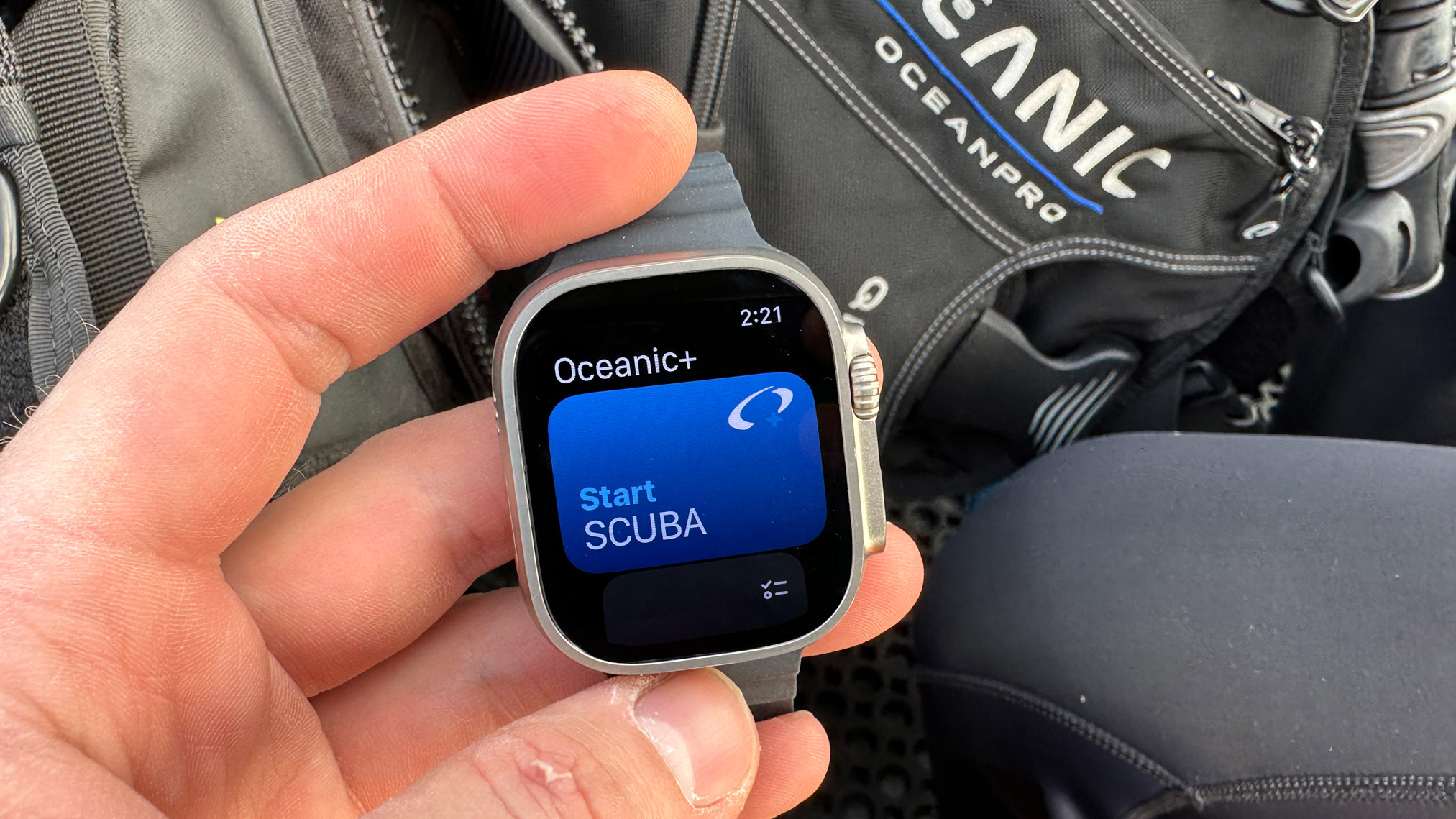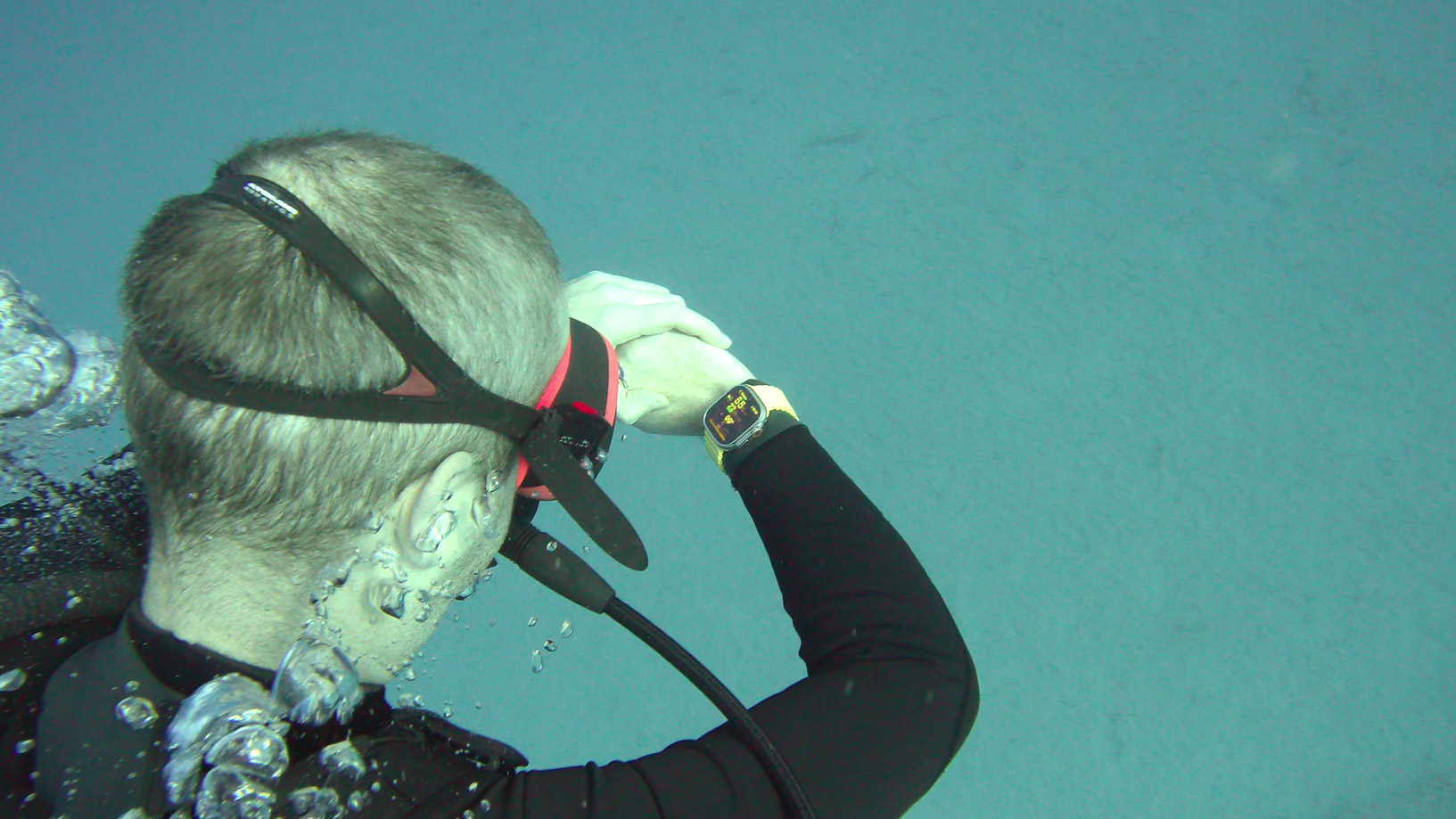Can Apple Watch Ultra really replace a dive computer? We asked an expert diver
A deep dive into the Apple Watch Ultra’s Oceanic+ app

The Apple Watch Ultra is billed as a watch that can support you throughout your adventuring highs and lows – sometimes literally. Designed to withstand temperatures from -4F / -20C to 130F / 55C, and with a built-in altimeter and compass, and water-resistance to 50 meters, this is wearable that promises to be an essential companion whether you're up a mountain or beneath the waves.
We weren’t able to test the watch to such extremes in our initial Apple Watch Ultra review, but even so, Apple's top-of-the-line Watch has already earned its place on our list of the best Apple Watches. We have a sneaking suspicion that most Ultra buyers won’t be taking full advantage of the watch’s abilities either: it’ll mostly be on the wrists of weekend warriors who might jump at the chance to do a 10K trail run, or surf in the winter (like me), but aren't planning on going on a multi-day hike in the Andes (unlike TechRadar's own Michelle Rae Uy).
However, Apple has taken the next steps to make the Ultra a true adventurer’s partner. In collaboration with Huish Outdoors, it's released the Oceanic+ app for the Apple Watch Ultra, which effectively turns the Ultra into a dive computer. The app's free plan allows scuba divers to calculate their position with undersea GPS tracking, and features a diver’s logbook, depth gauges, picture sharing, and alerts if you reach your maximum depth.
The paid subscription plan adds more sophisticated diving tools, such as the ability to calculate your no-decompression limit – that is, the time a diver will be able to spend at a given depth without the risk of suffering decompression sickness, aka the bends, were they to return directly to the surface without performing decompression stops.
Tide predictions, a UV index, and weather forecasts are also included in the paid plan, which costs $79.99 / £81.99 / AU$129.99 annually. If you’re an irregular diver, you can pay per month for as long as you need the app, or just use the free version, but serious divers will need to shell out if they want to get the most from the Ultra and Oceanic+.

Dive watches are nothing new, but they’re usually intricate analog watches or purpose-built digital models, rather than an app loaded onto an (albeit feature-rich) smartwatch. So can the Apple Watch Ultra, teamed with the Oceanic+ app, replace dedicated dive computers made by the likes of Garmin – as promised by launch footage of divers using the Ultra – or is it all a bit of a gimmick?
To find out, TechRadar asked Torben Lonne, co-founder of diving and adventure website Divein and a PADI Master Scuba Diver Trainer, about his experiences with the Apple Watch Ultra.
Sign up for breaking news, reviews, opinion, top tech deals, and more.
“[To test the Ultra] we dived with the dive computer on the wrist, with a second dive computer mounted on the other wrist,” said Lonne. “The second dive computer will work as a reference for the dive time, depth and no decompression limit. Afterward, we mount a series of comparable dive computers on a rack to check that readings are the same, look at the brightness and readability of the screen, and see when and how alarms are displayed.
“The Apple Watch Ultra has the brightest screen of any dive computer we have tested, making it easy to see the data in any condition. The information is displayed nicely in an easy-to-read format. There are clear visual, haptic, and audible alarms whenever the diver reaches a limit, gets to a safety stop, or ascends too fast.”
That's good news for divers, so far, with the Apple Watch Ultra’s updated retina display and 2000 nits of brightness allowing it to shine in the undersea murk. The more prominent digital crown and Action Button, meanwhile, are designed to allow divers, as well as athletes and outdoor adventurers, to operate the watch in a basic capacity while wearing gloves.

“Usability-wise, it's clear to see that it's an Apple product,” says Lonne. “Out of the box, I could use this dive computer as easily as I can the Garmin Descent MK2i I've been using for the last two years.”
Although the Oceanic+ app's dive computer software is good, spending a premium on a watch and then paying extra for additional diving features is a high barrier to entry. However, the Garmin Descent MK2i Lonne mentioned above retails for almost double the price of the Apple Watch Ultra, so if you're set on getting the Watch Ultra anyway, the extra subscription is a somewhat affordable alternative for casual divers.
Lonne believes the Watch Ultra and Oceanic+ combo won’t replace a dedicated dive computer for serious divers, but, as we'd though would be the case, he thinks it’s a nice alternative to hobbyists who might otherwise rent a computer when they pick up the rest of their gear.
“It won't be used by ultra-divers seeking depth or advanced diving; therefore the ‘Ultra’ name might be a miss for the diving parts of it,“ he says. “Still, I see a lot of divers using it, the ones that are diving for a few weeks or months a year. These are the divers that would typically rent a dive computer in the dive center.”
So, the Oceanic+ app appears to be a worthwhile addition to the Apple Watch Ultra's already-impressive array of hardware and software. It works as intended; it's easy to use; it shows the necessary information; and it's comprehensive enough to impress a professional diver. Sure, the Ultra's all-in-one approach is better suited to dilettantes and jacks-of-all-trades rather than enthusiast divers or professionals, but Apple knows this is where the demand is. For most of us, it's enough to wear the Ultra and use it as a running watch, safe in the knowledge we could dive with it if we ever wanted to. And we might… but we probably won't.

Matt is TechRadar's expert on all things fitness, wellness and wearable tech.
A former staffer at Men's Health, he holds a Master's Degree in journalism from Cardiff and has written for brands like Runner's World, Women's Health, Men's Fitness, LiveScience and Fit&Well on everything fitness tech, exercise, nutrition and mental wellbeing.
Matt's a keen runner, ex-kickboxer, not averse to the odd yoga flow, and insists everyone should stretch every morning. When he’s not training or writing about health and fitness, he can be found reading doorstop-thick fantasy books with lots of fictional maps in them.